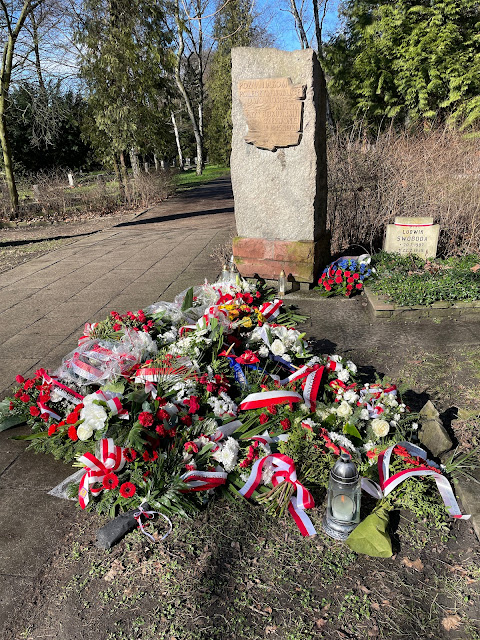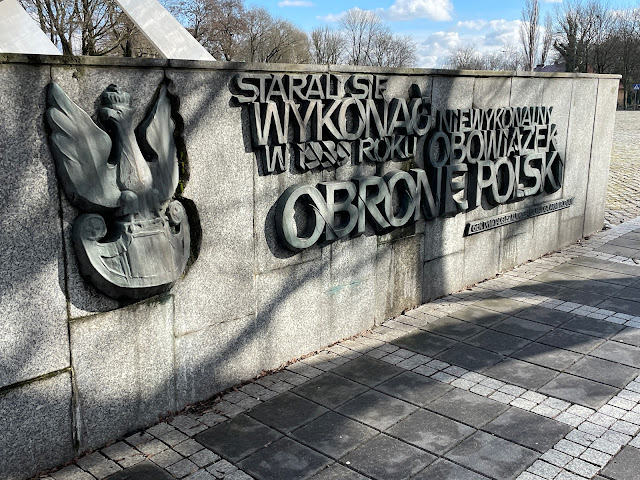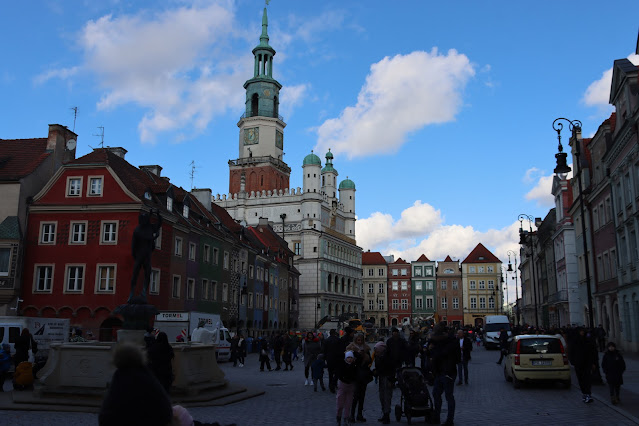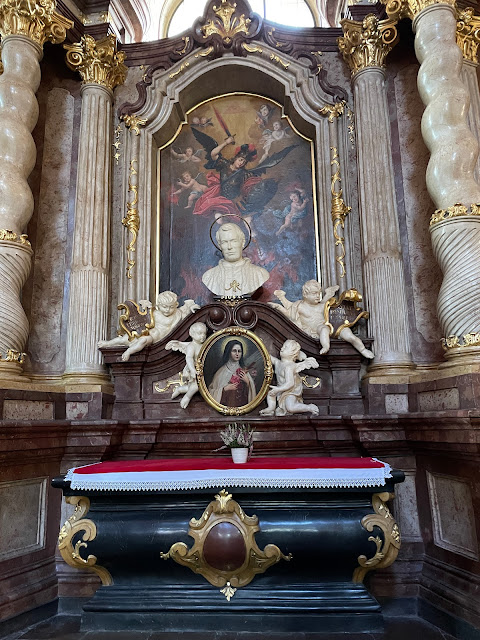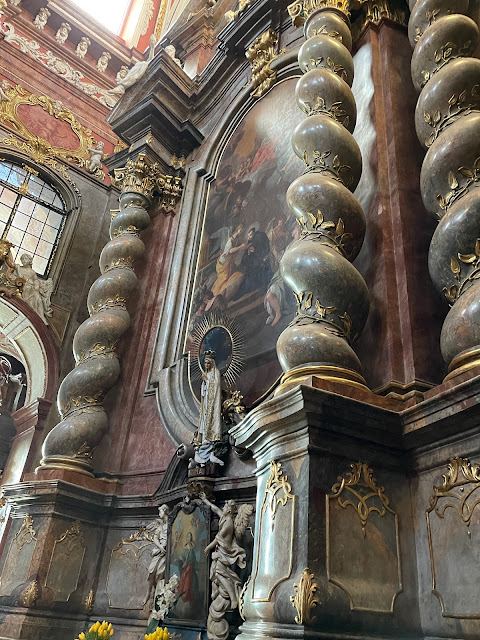We'd debated a little about what to do on our last day. We were due to catch the ferry at 1am that night and the drive was about 5 hours, depending on traffic and farmer protests. So we sketched some numbers together and realized that we would have time to see some of Poznań. I wanted to see a Lego Historyland, but it didn't open until 10 and we had to move the car before then.
So we decided on Park Cytadela (Citadel Park). The park is built on the site of Fort Winiary, which was a fortification from the 1800s. The park contained a military museum, rose garden and a large number of military cemeteries.
We found a car park at the side of the park and went in for a look.
First we came to the Pomnik "Poległym i pomordowanym w walce o niepodległość ojczyzny" - the Monument to those killed and murdered in the fight for the independance of the homeland.
This was followed by the rose garden, which wasn't super exciting in the middle of February:
Next up was the military museum - we didn't enter but did get some nice photos:
In the center of the park was the obelisk commemorating that Soviet Soldiers. The red star was removed when Poland gained independence. The "Monument to Heroes" commemorates the soviet soldiers that died in the battle to free Poznań from the Germans in 1945.
Behind the monument were a large number of war cemeteries. I think the most haunting thing with cemeteries from the wars, is seeing so many gravestones with the exact same date on them.
The first ones were for soldiers that died in the protests against the communist government in 1956. Approximately 100,000 people gathered in Poznań to protest against the communist Polish People's Republic. The government responded by deploying 390 tanks and 10,000 soldiers. It is estimated that 57-100 people were killed, the youngest being a 13 year old boy and 600 were wounded. 8 soldiers were also killed.
Followed by a monument for those from Poznań who died alongside the soviets in the fight to liberate Poznań in 1945.
There is also a Commonwealth cemetery with graves for those killed in prisoner of war camps and in both World Wars. There are several Australian graves and also a set of graves of those killed in "The Great Escape" from Stalag Luft III.
The graves of those who were killed after The Great Escape, including R Bushell, the man believed to have masterminded it.
Nearby was also the Soviet cemetery for the allied soviet forces killed in 1945, this stretched for quite a way:
We still had a fair bit of time left , so debated what to do next. I recalled that the town hall had a clock that had a set of mechanical goats that came out at midday and it was just after 11:30. So we decided to take a walk to the town square.
On the way, we passed the Pomnik Armii Poznań, the Poznań army monument:
We arrived at the Poznań town hall about 5 minutes to midday and the crowds were gathering despite the construction work around the area. The Town Hall (ratusz w Poznaniu) was built in 1253 and rebuilt in the 1500s.
At midday every day a traditional bugle call is played (Hejnał), St Mary's Trumpet Call, legend says it is the warning played by the trumpeter in Krakow to signal the Mongol attack.
The story behind the goats is that a cook had burnt the roast deer he was cooking for the voivode (a military leader), so he tried to replace by stealing two goats. They escaped and ran up the tower and began to headbutt each other, to the enjoyment of the townspeople.
The frescoes around the wall are in Latin and are a warning to judges.
After the goats, we walked around the square:
Our final stop in Poznań was the Basilica of Our Lady of Perpetual Help in Poznań Fara (Fara Poznańska).
This church was built between 1651 and 1701 and has an altar from the 18th century which is 17m high.
The window behind the altar let the sun in directly at midday and made it quite bright at the front of the church:
We then headed back to the car and started on our way out of Poznań. On the way we stopped to check out Lech Poznań Stadium, but unfortunately it was a game day so we couldn't take the tour:
From there we headed to our final stop before the ferry - the giant Jesus statue we had seen on the way in. It was about an hour out of town on the way to Świnoujście.
The statue is called "Christ the King" and is in the to Świebodzin. It is the tallest Jesus statue in the world - at 33m on a pedestal of 16.4m it is taller than the Christ the Redeemer statue in Rio de Janeiro (30.1m).
The construction commenced in September 2006 and finished in November 2010. It was funded by the residents of the town and international donors. The total cost was US$1.5million.
 |
| The statue was visible on the horizon from 7km away... |
 |
| Lighting rods in the hands - would look very cool if they got struck! |
From the statue we had a four hour drive to the ferry at Świnoujście.
The last strange sight of Poland was some strange igloo-like buildings:
They are part of a complex called Alvernia Planet - originally a film studio and now for hire and running virtual reality events.
The rest of the drive was fairly uneventful. We stopped for dinner and burnt a bit of time, before arriving at the ferry terminal around 8pm. Our ferry was due at 1am, so we wouldn't be able to board until around midnight.
We played around with our phones and iPads for the next few hours and boarded as expected at midnight. Luckily we had cabins, so once we had parked we went straight to our rooms and got to sleep.
The ferry arrived in Trelleborg around 8:30am, but it was 9:30 by the time we got off (our car was right at the front, stuck between multiple trucks).
We were home by 10am.
We didn't get to see all of Poland, but we did get a great snapshot, including three of the main cities and a couple of the main tourist sites.
















